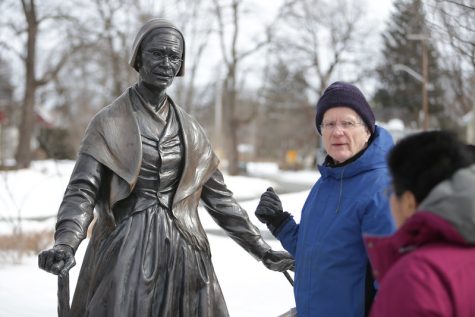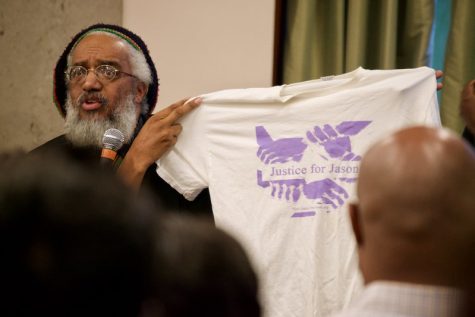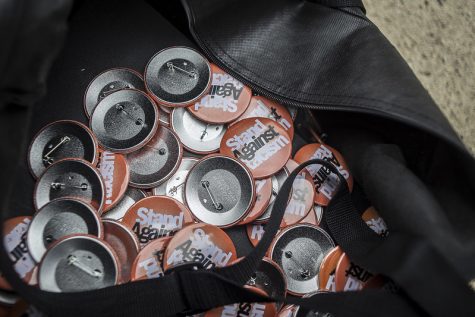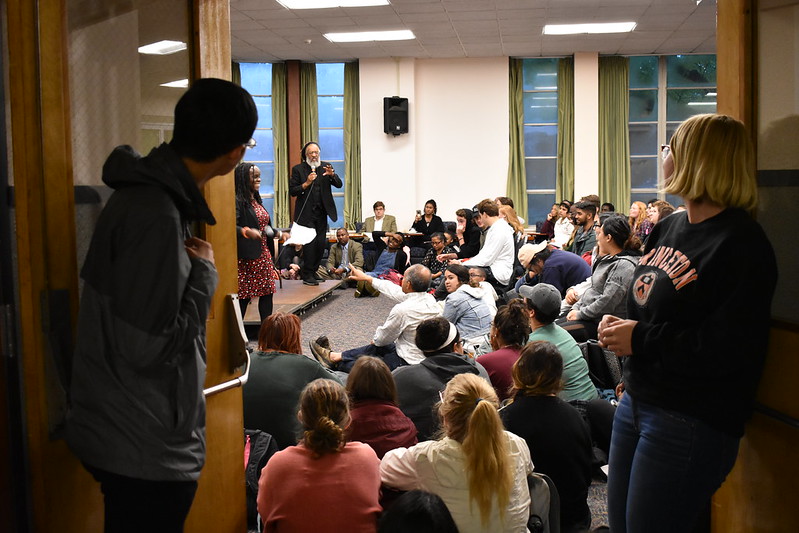Students listen to Dr. Amilcar Shabazz speak at the Racial Profiling Teach-In at the Student Union, Amherst MA. Joe Frank/Daily Collegian (2018).
The fight for Black equity: How Amherst and Northampton communities are owning up to their racially harmful past and present
The Pioneer Valley is making strides towards reparative efforts and racial atonement for Black residents
April 8, 2023
The first year that Dr. Amilcar Shabazz began his work as the seventh chair in the University of Massachusetts’ Department of Afro-American Studies, the liberal balloon popped.
It was Super Bowl 2008 when a Black student was verbally and physically attacked in Southwest residential area by two white men who were not students at the University, and he physically defended himself against his racially-motivated attackers.
Northwestern District Attorney Elizabeth Scheibel’s office indicted the Black student with two counts of aggravated assault and battery with a weapon. Threatening 30 years in prison if convicted, Scheibel did not budge on the prosecution until the defense made a motion to make a case of racial bias. The student was eventually charged at a misdemeanor level, “but his life was disrupted. He’d never finished UMass, he ended up leaving,” Shabazz said.
“That, for me, was kind of the initial sort of burst, the liberal balloon,” Shabazz said. “It just burst that balloon.”
This liberal balloon that Shabazz talks about refers to the accepting, tolerant and “liberal” atmosphere that seemingly encompasses the culture of the Pioneer Valley. While there is a deep history of abolitionist activism —such as figures like Sojourner Truth who came to Florence in 1843 when she joined the Northampton Association of Education, and Frederick Douglass who spoke at the city’s town hall in 1844— the city of Northampton has a majority white population, with 86 percent of residents being white and approximately 6.5 percent being Black or mixed race of Black descent, according to the U.S. Census Bureau’s 2020 report.
“[The Pioneer Valley has] its own problems, the legacy of slavery, the long shadow of slavery is right here, affecting our reality,” Shabazz said.
Today, Amherst and Northampton communities are pushing for reparative efforts and racial atonement for Black residents, which seeks to address these racial disparities within the local area — and they are one of the first communities in the United States to develop reparative initiatives municipally.

The History and the Initiative
The idea of reparations has existed for a long time. Dr. Martin Luther King Jr. addressed it in his ‘I Have a Dream Speech’ in 1963 at the Lincoln Memorial: “We’ve come to our nation’s capital to cash a check.” At face value, Dr. King’s words spoke to monetary compensation for Black Americans. But it is important to understand that the word “reparations” merely scratches the surface, as the issue is much more comprehensive and complex. It encompasses an intricate studying and redressing of racial harms, disparities and injustices that have occurred in the U.S. against enslaved people and descendants of slavery.
UN Human Rights Chief Michelle Bachelet stated, in her report, five key elements that reparative action should include: compensation, restitution, rehabilitation, acknowledgment of injustices and guarantees of non-repetition. This definition provides a more complex and multi-dimensional picture of the extensive work that must be done in order to deal with our racist past and present.
Amherst District 1 Town Councilor Michele Miller grew up in a predominantly suburban white community. At 40 years old, she just started to understand the country’s “original sin.” She didn’t know much about reparations until she wrote an opinion piece following the murder of George Floyd in 2020. She realized, through her research, that this work “starts from one’s own individual reparations.”
Miller co-founded Reparations For Amherst with Matthew Andrews, a non-Black advocacy group that focuses on achieving reparations for Black residents in Amherst. The group created a petition asking for the establishment of a funding source, as well as a commitment to ending structural racism in Amherst and a formal apology for anti-Black structural racism. Gaining traction, the petition was met with support from many community members, and Miller organized a group of residents together to develop a partial historical timeline.
Reparations For Amherst reached out to Evanston, Illinois alderman Robin Rue Simmons, who helped lead the country’s first reparation 2021 on a local level for Black residents. “She really encouraged us to continue doing the historical research and also to tie that historical research to current day disparities,” Miller said. This inspired the second report that the group drafted, diving into Black and white disparities in Amherst, “[tying] them to the particular harms of our community,” she said.
The report found that there are racial disparities that lie within many aspects of the Pioneer Valley, and provided data specific to the area. According to Cooley Dickinson Hospital’s findings cited in the report, local Black residents suffer higher rates of chronic illnesses. The report also noted that Black patients face racial bias when seeking medical attention. Food insecurity specifically in Hampshire County affects 38 percent of households, and 24 percent of people using the Amherst Survival Center food pantry were Black in 2020. COVID-19 significantly affects the Black population, with Black people dying at a rate of 1.4 times the rate of white people, according to The Covid Tracking Project’s 2020-2021 data.
“Marginalization, isolation, and exclusion that results from interpersonal and institutional racism have negative consequences for Black residents in Amherst,” Miller stated in the report. “Living under systemic racism perpetuates a state of physiological stress, ultimately causing physical and mental illness.”
The next step for the organization was to see if the Town Council was ready to support its initiative. “We gained the support immediately of three councilors who worked with us to draft a resolution. And I think that was really the first foundational piece of the scaffolding that led to the sort of, the rest of what happened after that, like the creation of the committee and the fund,” Miller said.
The African Heritage Reparations Assembly (AHRA) was established thereafter in June 2021. The assembly is composed of six Black members and one representative from Reparations For Amherst, being Miller. Shabazz spoke with Miller about their efforts in creating the AHRA, who then joined the group. “You’re talking [the] talk, let’s walk the walk. And they began to walk the walk,” Shabazz said.
Although the assembly is community-based, they are connected to other municipal reparation groups, who provide communication and guidance on their efforts. In December 2021, Shabazz, Miller and other AHRA members went to a summit with people in Evanston, which was “a process of going outside to figure out what we should do on the inside,” Shabazz explained.
The AHRA’s charge stands to develop and recommend to the Town Council a reparations plan along with a community-based reconciliation process for harms against Black residents of Amherst. They collaborate with different groups who are also working for racial justice and repair and integrating community stakeholders into the funding process.
The AHRA established a source of funding, modeling its reparative fund after the cannabis tax revenue. The municipality has committed to putting in $2 million of free cash, community funds that are unrestricted and available for use, into the fund over the next ten years. The town of Amherst aims to set aside $200,000 annually, although the actual amount will match the cannabis tax revenue from the previous year. Miller said that the AHRA also wants to pursue other sources that will increase funding, with ideas such as a private fund which residents can contribute to, as the group is looking into direct cash benefits.
Shabazz talked about five critical areas that the AHRA looks to engage with — housing and homeownership, the racial wealth gap, criminal justice system disparities, health disparities and peoplehood and the dignity gap.
“What our hope is [is] to really identify the harms in our community,” Miller said “[harms experienced by] current Black residents, and also residents who have moved from the community for whatever reasons, and some of those reasons may be linked to harms that they’ve endured in the community,” Miller said.

The Harms
The City of Northampton shortly followed with its racial atonement efforts. The Northampton Reparations Committee (NRC), a seven-member group, was established in 2021 with the goal of collaborating residents with the City Council and Mayor Gina-Louise Sciarra in a commission-based form, seeking to study the racial harms of the city and any recommendations in repairing those harms. NRC created a petition for reparations which successfully reached over 1,300 signers.
This February, Northampton’s council unanimously voted to pass a resolution that will establish a commission to study racialized harms and disparities in the community. The resolution, sponsored by City Councilors Jamila Gore, Garrick Perry and Marissa Elkins, concentrates on three central parts: acknowledgment, apology and rectification. The joint commission’s resolution also cited Northampton’s participation in slavery from 1654 to its abolishment in Massachusetts in 1783. Since then, the city has enforced discriminatory zoning laws and loan practices, as well as disproportionate staffing in schools, public offices and departments.
Recently, on March 30, the commission presented to the council a timeline detailing the ways in which the committee will be organized and formed. The commission seeks to have nine-to-10 members, at least 50 percent of the committee being Black residents. The city may appoint up to two councilors, and some members will be appointed by local commissions.
City Councilor at large, Jamila Gore, one of three Black residents to have ever served on City Council, said “It’s a good step in influencing other communities to get on board with this idea of looking at racialized harms, and what can we do to redress the harms that have been done.”
Gore, who grew up in the suburbs of St. Louis, Missouri, was the only Black girl in her kindergarten class. “I am used to being the only one a lot of the times,” Gore said. While it is something that she has gotten used to, “It can be kind of isolating though…you kind of have to push beyond the boundaries of race to kind of get to people,” she said.
Gore shared one particular moment of being a Black woman living in a predominantly white city. Trying to find an outlet during the grips of COVID-19, Gore had her own plot in the community garden. There was talk about the ways to improve the community garden’s racial equity, as she noted how some Black people did not feel comfortable having a plot. One day, while Gore was tending to her plot, a white woman came up to her in her car. Gore recalled the woman asking, “Is that your plot or are you here for community service?”
Reflecting back on the instance, “I was just looking for an outlet to be outside,” Gore said, and to have been approached like that, “It wasn’t fair, and it wasn’t right.”
Councilor Garrick Perry, one of two current Black councilors in Northampton along with Gore, came from Washington, D.C. to Amherst College in 1997. “I happened to be in a class at Amherst that had a lot of forward-thinking folks and a lot of forward-thinking Black students. So we were really tight knit,” he said.
Perry began working in the Pioneer Valley in 2001 and was recently elected to Northampton’s council in 2021. “This has all been very recent. It’s only been the last two terms that there have been any black community members on City Council,” he said.
Perry, along with Gore, joined Northampton’s racial atonement initiatives after being approached by the NRC to include more Black voices, “Because unlike Amherst, which has a fairly stable and strong African American population, there’s, you know, communities and generations. Northampton isn’t like that, you know, it’s kind of these disparate groups,” Perry said.
“The meat of it is really also understanding that Northampton has a huge history of abolition work. And so, you know, we wanted to celebrate that, but also kind of have a wide-ranging approach,” Perry said. With this, he cited the ways that the city is actually hurting because of the lack of a strong Black population, especially from a business standpoint.
“This lack of diversity costs the city, whether it’s innovation, creativity, culture,” Perry said. “Without the presence of a diverse population, you really limit your ideas, and so we really wanted to be open to having the committee use every tool.”
While Northampton’s joint commission has not been established yet, Perry’s ideas of what these tools could entail may look like incentives for Black-owned businesses, a diversity hiring expert, a citywide Black History Month celebration and more. “When you come to a place, and everything just seems oh-so-white, and there’s nothing for you, there’s no reason for you to stay,” he said.
Perry stressed that there needs to be more Black businesses and more Black vision. “One of the things that hurts me is that I have two daughters, and there’s no black hair salons,” he said. “Those are places where culture is, you know, the barber shop and the hair salon.” His second-grade nephew, who goes to school in Northampton, visited the mayor on a class field trip. One young student in the class asked why all of the mayors on the wall were white. To this, Perry said that it is important to “have a seat at the table to give this diversity of not only culture, but of ideas and creativity.”

The Black Student Population
Another issue that Perry raised is the large population of students in the Five Colleges. The question becomes if Black students, who make up the majority of Amherst’s Black population, will be included in the conversation. With the AHRA’s report due in June 2023, the Amherst group is discussing ideas in which the Black student population could be affected. “We would very much like to find inroads at UMass, to hear from Black students about their experience, not only as students at the University, but in the town,” Amherst Councilor Miller said.
Miller spoke with a Black student who felt that they were invisible in Amherst. “What are the circumstances that lead somebody to feel invisible? Is it that they don’t see any street names named after them, or any buildings that in which they would identify?” Miller said.
Perry echoed a similar feeling that Black students may feel in a predominantly white town. “There are people who are temporarily living here, but very few of them stay for long, or make their lives here,” he said.
“Being a Black person or minority in a majority white area every day is the work. You know, like just regular everyday things —going to the grocery store— things take a different tone when you are, you know, one of few,” Perry said.
At UMass, the Afro-American Cultural Education (AACE) group is at the heart of this conversation. The group regularly advertises the AHRA’s meetings and held a reparation summit of its own on April 1.
Ciara Cosby, a 2017 UMass graduate and founder of the group, noticed that there were very active cultural groups on campus, yet none that specifically focused on African Americans who are descendants of enslaved people. “It was hard to actually find Black Americans on the campus who are actually, you know, descendants of slavery…The main issue that we wanted to address and to make sure that we can preserve the identity on campus and in the community,” Cosby said.
Now an advisor for the AACE, Cosby goes to AHRA meetings often to help build student engagement in the reparative process. She sees Amherst’s efforts as an opportunity for UMass, which is a land-grant University, she noted, to reflect upon its own harms and to look at “what kind of policies or practices are in place at the university level that can be adjusted to better address the needs of Black students to deal with its own history,” Cosby said.
One suggestion that Cosby has for the AHRA is disaggregating data within African American descendants of enslaved people, as there is a lack of data that specifically identifies the past population of descendants of enslaved people in Amherst. She wants an investigation that details descendants of slavery history dating from when Amherst was founded in 1759. Cosby also suggests that there be a municipal office for descendants of enslaved people to identify any local disparities within the community.
“It’s really important that we have some level of data disaggregation, to be able to identify what the root of some of the issues that are impacting our community, to be able to fully find solutions for them that will be sustainable,” Cosby said.
Cosby and Zach Steward, senior African American studies and legal studies double major and president of the AACE, both expressed that there is a key distinction between local and federal reparative efforts, and what they entail.
“What’s happening in Amherst is within a larger network of national efforts for reparation,” Cosby said. “In order to fully repair descendants of American slavery, it has to be a federal program.”
“We want to think big,” she said.
The local efforts provide a foundation for the federal level. In this lie challenges, though, as local municipalities do not always have the same set of resources to comprehensively correct racial disparities. “What the local efforts can do is create infrastructure to support federal programs,” Cosby said. “But we also have to make sure that it’s not something that will take away from the federal program, but always building up to it.”
Cosby’s solution for this: practicality. “It has to be focused on what can you actually do practically at the local level to support the federal program,” she said.
But one important thing to understand is that the idea of reparative efforts for one person may not be the same as the others’; fully grasping that not everyone’s definition of reparations is the same, either, is also essential. “As it has been said, more than once for generations and generations, we are not a monolith, we are not the same. We all have different ideas about how we view the world, and those ideas should be taken into account,” Steward said.
He continued, “Reparations to me means to be able to live, one, but to be able to live comfortably, and live life without fear and without reprisal.”

The Bigger Picture
Statewide and federally, government officials are beginning to discuss reparations again. The 1989 HR 40 bill, the Commission to Study and Develop Reparation Proposals for African Americans Act, has been reintroduced by Rep. Sheila Jackson Lee (D-TX) and Sen. Cory Booker (D-NJ). The state of Massachusetts has created two bills for reparations. Sponsored by Hampshire County State Rep. Mindy Domb, S. 1053 proposes a commission studying reparations in Massachusetts. The second bill, S. 1050, seeks to create reparations for descendants of slavery.
Boston Mayor Michelle Wu also recently announced in February the appointed members for a reparations task force that will study the history of slavery, engage the community and provide recommendations to Mayor Wu on next steps.
The process will be long, but nevertheless is interconnected between local communities. “There’s not one check one and done,” Shabazz said. “We’re going to have to be as ongoing, long term, systemic, systematic, about confronting our problem of racism in this country as we were in getting into this space.”
Northampton Councilor Perry noted that Easthampton is also looking into racial atonement. “I feel like what we’re trying to do, inevitably affects all the surrounding cities. And I think that hopefully together the more folks who combine to work on this, the easier it’ll be on the federal level,” he said.
But many challenges still exist. Shabazz said that after eight years of former President Obama, “This country has gotten so overt and ugly, and it’s racism, and [it’s] only getting uglier every day.” Now with Gov. Ron DeSantis’ (R-FL) attack on African American studies and critical race theory, it’s clear that racial discrimination and silencing of Black studies are on the rise.
“We’ve lived the harm. We know the wrong, we live it, we suffer from it, even to this day. It’s in our genes,” Shabazz said.
“So for me, this moment, this work is about us stepping up in the truth of our story, in the truth of Black folks’ reality, to confront the problem, to name it, to call it out, and to demand ongoing work and attention to it,” he said. “This is a much bigger fight. It doesn’t end in Amherst at all.”
Caitlin Reardon can be reached at [email protected]. Follow her on Twitter @caitlinjreardon.
